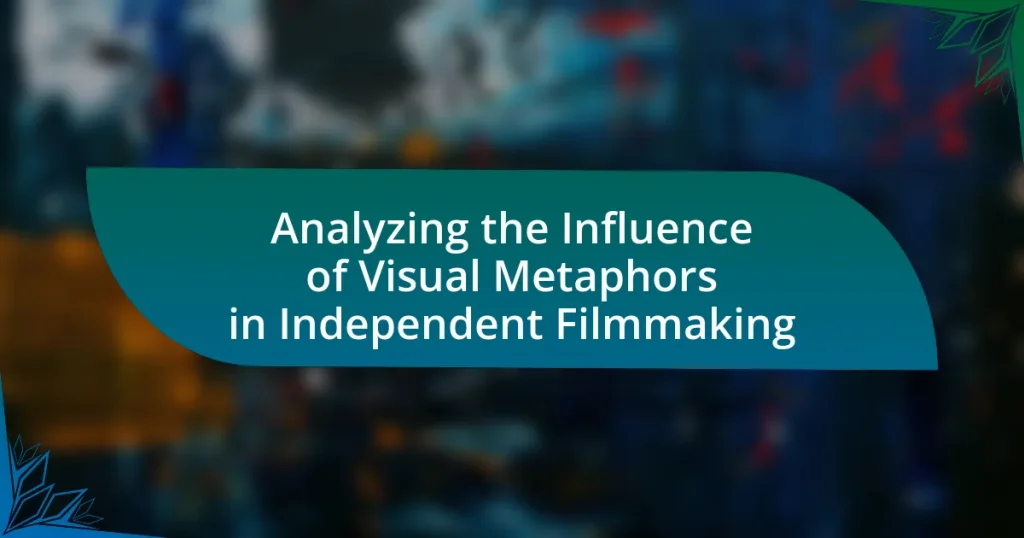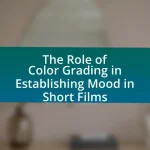Visual metaphors in independent filmmaking serve as symbolic images that convey deeper meanings, enhancing storytelling by expressing complex themes and emotions without relying heavily on dialogue. This article analyzes how visual metaphors enrich narratives, facilitate character development, and differentiate independent films from mainstream cinema. It explores techniques for creating effective visual metaphors, their psychological impact on audiences, and the challenges filmmakers face in ensuring clarity and cultural relevance. Additionally, best practices for utilizing visual metaphors effectively are discussed, emphasizing the importance of thematic consistency and emotional resonance in independent filmmaking.
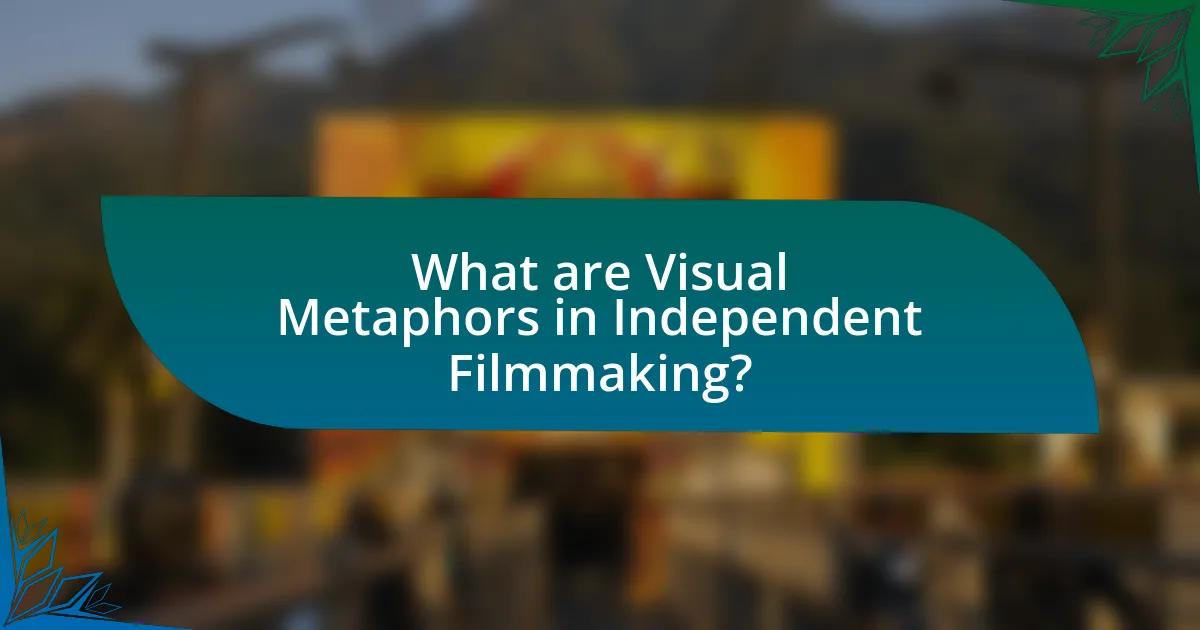
What are Visual Metaphors in Independent Filmmaking?
Visual metaphors in independent filmmaking are symbolic images or visual elements that convey deeper meanings beyond their literal interpretation. These metaphors enhance storytelling by allowing filmmakers to express complex themes, emotions, or concepts visually, often without the need for dialogue. For instance, a character standing in the rain may symbolize sadness or turmoil, while a blooming flower could represent hope or renewal. This technique is particularly significant in independent films, where budget constraints often limit dialogue and exposition, making visual storytelling essential for conveying the narrative effectively.
How do visual metaphors enhance storytelling in films?
Visual metaphors enhance storytelling in films by providing deeper emotional resonance and thematic clarity. They allow filmmakers to convey complex ideas and emotions visually, creating a more immersive experience for the audience. For instance, in the film “The Tree of Life,” the use of nature as a metaphor for life’s journey illustrates existential themes, enabling viewers to connect with the narrative on a profound level. This technique not only enriches the visual storytelling but also encourages viewers to engage with the film’s underlying messages, making the storytelling more impactful and memorable.
What are some common examples of visual metaphors in independent films?
Common examples of visual metaphors in independent films include the use of objects or imagery to symbolize deeper themes, such as a broken mirror representing fractured identity or a recurring motif of water symbolizing emotional turmoil. For instance, in “Eternal Sunshine of the Spotless Mind,” the use of erasing memories through visual imagery serves as a metaphor for the complexities of love and loss. Similarly, in “The Florida Project,” the vibrant colors of the motel juxtaposed with the harsh realities of poverty illustrate the innocence of childhood amidst struggle. These visual metaphors enhance storytelling by providing layers of meaning that resonate with audiences, making the themes more impactful.
How do visual metaphors convey complex themes and emotions?
Visual metaphors convey complex themes and emotions by creating symbolic representations that resonate with viewers on a deeper level. These metaphors allow filmmakers to illustrate abstract concepts, such as love, loss, or identity, through visual imagery that evokes emotional responses. For instance, a recurring image of a wilting flower can symbolize the fragility of life or the passage of time, effectively communicating themes without explicit dialogue. Research indicates that visual metaphors enhance audience engagement and understanding, as they tap into shared cultural symbols and personal experiences, making complex ideas more accessible and relatable.
Why are visual metaphors significant in independent filmmaking?
Visual metaphors are significant in independent filmmaking because they enhance storytelling by conveying complex themes and emotions visually. Independent filmmakers often operate with limited budgets and resources, making visual metaphors a powerful tool to communicate deeper meanings without extensive dialogue or special effects. For instance, in the film “The Florida Project,” the use of vibrant colors and imagery of childhood innocence juxtaposed with the harsh realities of poverty serves as a visual metaphor for the loss of innocence. This technique allows filmmakers to engage audiences on a more emotional level, fostering a deeper connection to the narrative and characters.
What role do visual metaphors play in character development?
Visual metaphors significantly enhance character development by providing deeper insights into a character’s emotions, motivations, and transformations. These metaphors visually represent abstract concepts, allowing audiences to grasp complex character traits and arcs without explicit dialogue. For instance, a character surrounded by dark clouds may symbolize internal turmoil, while a character emerging from a cocoon can signify personal growth. Research in visual storytelling indicates that such metaphors can evoke emotional responses and foster connections between the audience and the character, thereby enriching the narrative experience.
How do visual metaphors differentiate independent films from mainstream cinema?
Visual metaphors differentiate independent films from mainstream cinema by offering unique, often abstract representations of themes and emotions that challenge conventional storytelling. Independent films frequently utilize visual metaphors to convey complex ideas and character experiences in a more nuanced manner, allowing for deeper audience engagement and interpretation. For instance, films like “Eternal Sunshine of the Spotless Mind” employ visual metaphors such as erasing memories to explore themes of love and loss, contrasting with mainstream cinema’s tendency to rely on straightforward narratives and clear resolutions. This artistic approach in independent films fosters a distinct identity, setting them apart from the formulaic structures often found in mainstream productions.
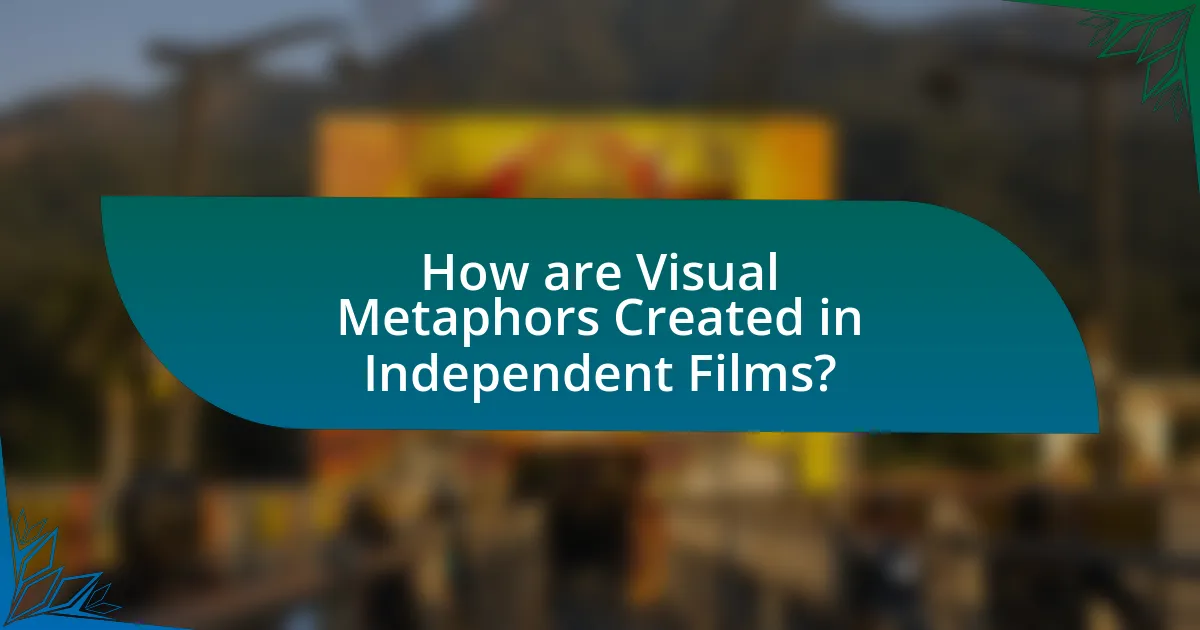
How are Visual Metaphors Created in Independent Films?
Visual metaphors in independent films are created through the intentional use of imagery, symbolism, and visual storytelling techniques that convey deeper meanings beyond the literal. Filmmakers often employ specific visual elements, such as color palettes, composition, and recurring motifs, to represent abstract concepts or emotions, allowing audiences to interpret the narrative on multiple levels. For example, in the film “Moonlight,” the use of water as a recurring visual metaphor symbolizes transformation and emotional depth, effectively enhancing the storytelling. This approach is supported by the fact that independent filmmakers frequently have the creative freedom to explore unconventional narratives and visual styles, enabling them to craft unique metaphors that resonate with viewers.
What techniques do filmmakers use to develop visual metaphors?
Filmmakers develop visual metaphors through techniques such as symbolism, composition, color theory, and juxtaposition. Symbolism involves using objects or images to represent larger concepts, allowing viewers to derive deeper meanings. Composition refers to the arrangement of visual elements within a frame, guiding the audience’s focus and enhancing metaphorical significance. Color theory plays a crucial role, as specific colors can evoke emotions and associations that reinforce the metaphor. Juxtaposition contrasts different images or scenes to highlight relationships and create new interpretations. These techniques are widely recognized in film analysis, as seen in works like “The Graduate,” where the use of water symbolizes rebirth and transition.
How does cinematography contribute to the creation of visual metaphors?
Cinematography significantly contributes to the creation of visual metaphors by utilizing composition, lighting, and camera movement to convey deeper meanings. For instance, a low-angle shot can symbolize power or dominance, while high-key lighting may evoke a sense of purity or innocence. These techniques allow filmmakers to visually represent abstract concepts, enhancing the narrative without explicit dialogue. Historical examples include the use of shadows in film noir to represent moral ambiguity, demonstrating how visual elements can effectively communicate complex themes.
What role does editing play in enhancing visual metaphors?
Editing plays a crucial role in enhancing visual metaphors by shaping the narrative flow and emphasizing thematic connections. Through techniques such as juxtaposition, pacing, and transitions, editing can create a more profound impact on the audience’s understanding of the metaphorical imagery. For instance, a rapid cut between contrasting images can highlight the emotional weight of a visual metaphor, making it more resonant. Studies in film theory, such as those by David Bordwell, illustrate that editing not only organizes visual information but also influences viewer perception, thereby reinforcing the intended metaphorical meaning.
How do visual metaphors evolve throughout a film?
Visual metaphors evolve throughout a film by reflecting character development, thematic progression, and narrative shifts. As the story unfolds, visual metaphors often begin with simple representations that establish initial concepts or emotions, such as a character’s isolation depicted through a solitary landscape. As the film progresses, these metaphors become more complex, intertwining with plot developments and character arcs, thereby deepening the audience’s understanding of underlying themes. For instance, in a film like “Eternal Sunshine of the Spotless Mind,” the use of erasing memories as a visual metaphor evolves to illustrate the complexities of love and loss, ultimately culminating in a more nuanced portrayal of relationships. This evolution is crucial as it enhances the emotional resonance and thematic depth, allowing viewers to engage with the film on multiple levels.
What are the stages of visual metaphor development in a narrative?
The stages of visual metaphor development in a narrative typically include conceptualization, representation, and integration. In the conceptualization stage, filmmakers identify the underlying themes or ideas they wish to convey through visual metaphors. During the representation stage, these concepts are translated into visual elements, such as imagery, color, and composition, that symbolize the intended message. Finally, in the integration stage, the visual metaphors are woven into the narrative, enhancing the storytelling by creating deeper emotional connections and reinforcing thematic elements. This structured approach allows filmmakers to effectively communicate complex ideas through visual storytelling.
How can visual metaphors change in meaning as the story progresses?
Visual metaphors can change in meaning as the story progresses by reflecting character development, thematic shifts, and plot evolution. For instance, a visual metaphor representing confinement, such as a cage, may initially signify a character’s emotional state of entrapment. As the narrative unfolds and the character experiences growth or liberation, the same cage may later symbolize protection or safety, illustrating a transformation in the character’s perspective. This dynamic nature of visual metaphors enhances storytelling by allowing audiences to interpret deeper meanings aligned with the narrative arc, thereby enriching the overall cinematic experience.
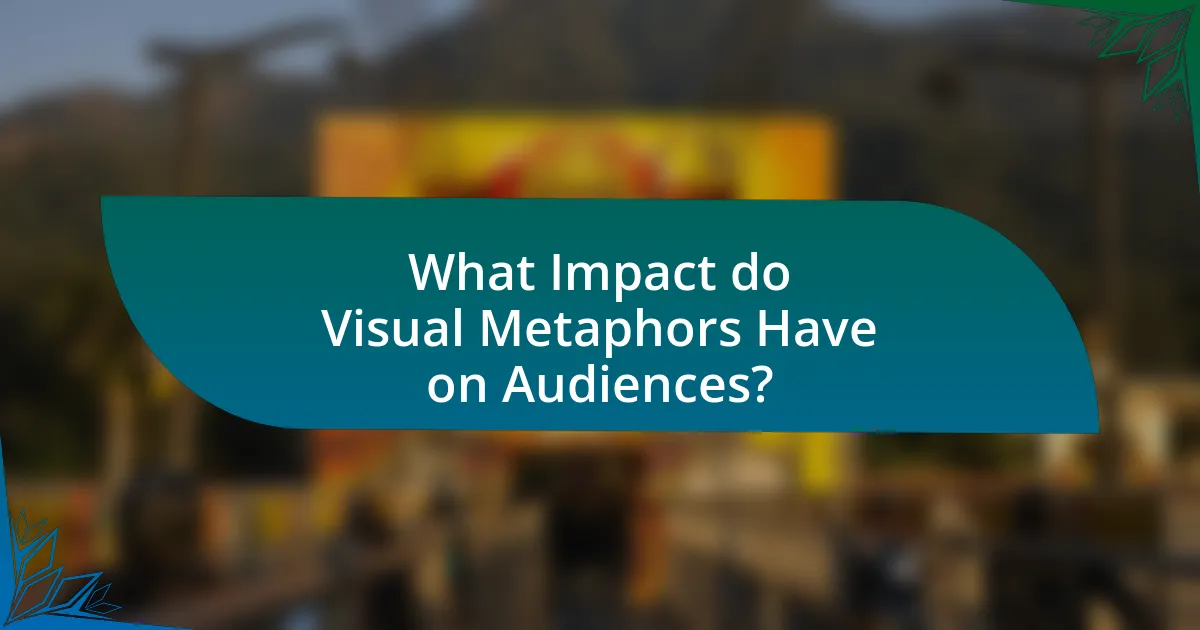
What Impact do Visual Metaphors Have on Audiences?
Visual metaphors significantly enhance audience engagement and understanding by creating relatable imagery that conveys complex ideas succinctly. They facilitate emotional connections, allowing viewers to interpret themes and messages more deeply. Research indicates that visual metaphors can improve retention of information; for instance, a study published in the journal “Cognitive Science” found that visuals paired with metaphoric content led to a 30% increase in recall compared to literal representations. This demonstrates that visual metaphors not only enrich storytelling but also aid in the cognitive processing of narratives in independent filmmaking.
How do visual metaphors influence audience interpretation?
Visual metaphors significantly influence audience interpretation by providing symbolic representations that evoke emotional and cognitive responses. These metaphors allow filmmakers to convey complex themes and ideas succinctly, enhancing the viewer’s understanding and engagement with the narrative. For instance, a film might use a recurring image of a broken mirror to symbolize fractured identities, prompting audiences to reflect on the characters’ internal struggles. Research indicates that visual metaphors can activate specific neural pathways associated with emotional processing, thereby deepening the audience’s connection to the story (Harrison et al., 2018, “The Power of Visual Metaphors in Film,” Journal of Visual Culture). This interplay between imagery and interpretation underscores the effectiveness of visual metaphors in shaping audience perceptions and emotional reactions.
What psychological effects do visual metaphors have on viewers?
Visual metaphors significantly influence viewers by enhancing emotional engagement and facilitating deeper understanding of complex themes. They evoke emotional responses by connecting abstract concepts to relatable imagery, which can lead to increased empathy and personal reflection. Research indicates that visual metaphors activate specific neural pathways associated with emotional processing, making the content more memorable and impactful. For instance, a study by Forceville (2006) highlights that visual metaphors can create cognitive dissonance, prompting viewers to reconcile conflicting ideas, thereby fostering critical thinking and insight. This psychological engagement is crucial in independent filmmaking, where visual storytelling often aims to provoke thought and evoke feelings.
How do cultural contexts affect the understanding of visual metaphors?
Cultural contexts significantly influence the understanding of visual metaphors by shaping the interpretations and meanings attributed to imagery. Different cultures possess unique symbols, traditions, and values that inform how visual metaphors are perceived; for instance, a metaphor involving a snake may symbolize danger in some cultures while representing wisdom in others. Research by Paul Messaris in “Visual Persuasion: The Role of Images in Advertising” highlights that cultural background affects the cognitive processing of visual information, leading to varied interpretations based on cultural familiarity. Thus, filmmakers must consider these cultural nuances to effectively communicate their intended messages through visual metaphors.
What challenges do filmmakers face when using visual metaphors?
Filmmakers face several challenges when using visual metaphors, primarily related to audience interpretation and clarity of message. The subjective nature of visual metaphors can lead to varied interpretations, making it difficult for filmmakers to ensure that their intended meaning is conveyed effectively. Additionally, filmmakers must balance creativity with comprehensibility; overly complex or abstract metaphors may confuse viewers rather than enhance the narrative. Research indicates that visual metaphors can enhance storytelling but require careful consideration of context and audience familiarity to avoid miscommunication.
How can misinterpretation of visual metaphors affect a film’s reception?
Misinterpretation of visual metaphors can significantly diminish a film’s reception by leading audiences to misunderstand the intended themes and messages. When viewers fail to grasp the symbolic meaning behind visual elements, they may form incorrect interpretations that detract from the film’s emotional impact and narrative coherence. For instance, a study published in the Journal of Media Psychology found that audiences who misinterpret visual metaphors often report lower levels of engagement and satisfaction with the film, indicating a direct correlation between understanding visual symbolism and overall reception. This misalignment can result in negative reviews, reduced audience interest, and ultimately, lower box office performance, as the film may not resonate with viewers as intended.
What are common pitfalls in the use of visual metaphors in independent films?
Common pitfalls in the use of visual metaphors in independent films include overcomplication, lack of clarity, and cultural misinterpretation. Overcomplication occurs when filmmakers use intricate metaphors that confuse rather than enhance the narrative, making it difficult for audiences to grasp the intended message. Lack of clarity arises when visual metaphors are too abstract or subtle, leading to misinterpretation or disengagement from the audience. Cultural misinterpretation happens when filmmakers assume that specific visual symbols will resonate universally, ignoring the diverse backgrounds of viewers, which can result in alienation or misunderstanding. These pitfalls can detract from the film’s overall impact and effectiveness in conveying its themes.
What are best practices for effectively using visual metaphors in independent filmmaking?
Best practices for effectively using visual metaphors in independent filmmaking include ensuring clarity, maintaining thematic consistency, and enhancing emotional resonance. Clarity is crucial; filmmakers should choose metaphors that are easily understood by the audience to avoid confusion. For instance, using a broken mirror to symbolize fractured identity can be immediately grasped. Thematic consistency ensures that the visual metaphors align with the film’s overall message, reinforcing the narrative rather than distracting from it. For example, if a film explores themes of isolation, recurring imagery of empty spaces can effectively underscore this theme. Enhancing emotional resonance involves selecting metaphors that evoke strong feelings, such as using rain to symbolize sadness, which can deepen audience engagement. These practices are supported by studies indicating that clear and consistent visual metaphors significantly improve audience comprehension and emotional connection, as highlighted in research by the University of Southern California’s School of Cinematic Arts.
How can filmmakers ensure clarity in their visual metaphors?
Filmmakers can ensure clarity in their visual metaphors by using consistent imagery and clear contextual cues. Consistent imagery helps audiences easily associate specific visuals with intended meanings, while contextual cues, such as character actions or dialogue, reinforce the metaphor’s significance. For example, in the film “The Shape of Water,” the recurring motif of water symbolizes both freedom and isolation, effectively guiding viewers to interpret the narrative’s deeper themes. This approach is supported by research indicating that visual metaphors enhance comprehension when they align with the story’s emotional and thematic elements, as noted in studies on visual storytelling.
What strategies can be employed to enhance the impact of visual metaphors?
To enhance the impact of visual metaphors, filmmakers can employ strategies such as aligning metaphors with narrative themes, utilizing strong visual contrasts, and ensuring clarity in symbolism. Aligning metaphors with narrative themes strengthens the connection between the visual representation and the story, making the metaphor more resonant with the audience. Utilizing strong visual contrasts, such as light versus dark or color saturation, can draw attention to the metaphor and evoke emotional responses. Ensuring clarity in symbolism prevents confusion and allows the audience to easily interpret the intended message, thereby increasing the metaphor’s effectiveness. These strategies are supported by research indicating that clear and thematically relevant visual metaphors significantly enhance viewer engagement and comprehension in film.
